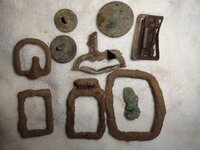Helix
Bronze Member
- Jul 27, 2013
- 1,425
- 1,315
- Detector(s) used
- Garrett gti 2500, Whites DFX
- Primary Interest:
- All Treasure Hunting
Went back to my "old settlers home site". Spent a hour or so hunting a new debris field I found the other day. A few buckles, 1848 LC, couple flat buttons, and what appears to be a small piece of float copper. Did find a large piece of lead and lots of iron.
 The old home site is in a fresh cut soybean field, nice and flat perfect for mding. Trying to hit it hard now before it is tilled and becomes a huge mess. That should be interesting tho after its tilled. Anyone have any advice for hunting farm fields?
The old home site is in a fresh cut soybean field, nice and flat perfect for mding. Trying to hit it hard now before it is tilled and becomes a huge mess. That should be interesting tho after its tilled. Anyone have any advice for hunting farm fields?
 The old home site is in a fresh cut soybean field, nice and flat perfect for mding. Trying to hit it hard now before it is tilled and becomes a huge mess. That should be interesting tho after its tilled. Anyone have any advice for hunting farm fields?
The old home site is in a fresh cut soybean field, nice and flat perfect for mding. Trying to hit it hard now before it is tilled and becomes a huge mess. That should be interesting tho after its tilled. Anyone have any advice for hunting farm fields?
Upvote
3








